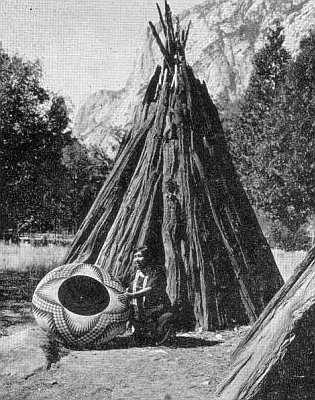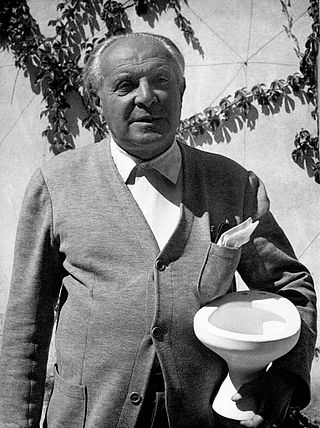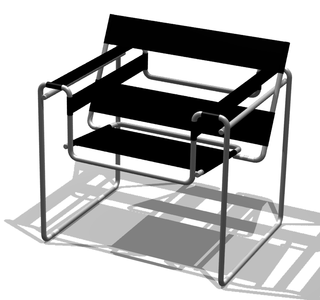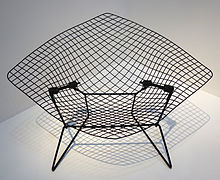
A shopping cart, trolley, or buggy, also known by a variety of other names, is a wheeled cart supplied by a shop or store, especially supermarkets, for use by customers inside the premises for transport of merchandise as they move around the premises, while shopping, prior to heading to the checkout counter, cashiers or tills. Increasing the amount of goods a shopper can collect increases the quantities they are likely to purchase in a single trip, boosting store profitability.

A chair is a type of seat, typically designed for one person and consisting of one or more legs, a flat or slightly angled seat and a back-rest. They may be made of wood, metal, or synthetic materials, and may be padded or upholstered in various colors and fabrics.

Harry Bertoia was an Italian-born American artist, sound art sculptor, and modern furniture designer.
Chairs are known from Ancient Egypt and have been widespread in the Western world from the Greeks and Romans onwards. They were in common use in China from the twelfth century, and were used by the Aztecs. In Sub-Saharan Africa, chairs were not in use before introduction by Europeans.

Wicker is a method of weaving used to make products such as furniture and baskets, as well as a descriptor to classify such products. It is the oldest furniture making method known to history, dating as far back as 5,000 years ago. Wicker was first documented in ancient Egypt, then having been made from pliable plant material, but in modern times it is made from any pliable, easily woven material. The word wicker or "wisker" is believed to be of Scandinavian origin: vika, which means "to fold" in Swedish. Wicker is traditionally made of material of plant origin, such as willow, rattan, reed, and bamboo, though the term also applies to products woven from synthetic fibers. Wicker is light yet sturdy, making it suitable for items that will be moved often like porch and patio furniture. Rushwork and wickerwork are terms used in England. A typical braiding pattern is called Wiener Geflecht, Viennese Braiding, as it was invented in 18th century Vienna and later most prominently used with the Thonet coffeehouse chair.

Florence Marguerite Knoll Bassett was an American architect, interior designer, furniture designer, and entrepreneur who has been credited with revolutionizing office design and bringing modernist design to office interiors. Knoll and her husband, Hans Knoll, built Knoll Associates into a leader in the fields of furniture and interior design. She worked to professionalize the field of interior design, fighting against gendered stereotypes of the decorator. She is known for her open office designs, populated with modernist furniture and organized rationally for the needs of office workers. Her modernist aesthetic was known for clean lines and clear geometries that were humanized with textures, organic shapes, and colour.

Basket weaving is the process of weaving or sewing pliable materials into three-dimensional artifacts, such as baskets, mats, mesh bags or even furniture. Craftspeople and artists specialized in making baskets may be known as basket makers and basket weavers. Basket weaving is also a rural craft.

Netball Australia is the main governing body for netball in Australia. It is affiliated to World Netball. It is responsible for organising and administering the Australia national netball team, Suncorp Super Netball and the Australian National Netball Championships. It previously organised and administered the Australian Netball League, the ANZ Championship, the Commonwealth Bank Trophy league and the Esso/Mobil Superleague.
Karl Emanuel Martin "Kem" Weber (1889–1963) was an American furniture and industrial designer, architect, art director, and teacher who created several iconic designs of the 'Streamline' style.

Giovanni "Gio" Ponti was an Italian architect, industrial designer, furniture designer, artist, teacher, writer and publisher.

Knoll is an American company that manufactures office systems, seating, storage systems, tables, desks, textiles, as well as accessories for the home, office, and higher education. The company is the licensed manufacturer of furniture designed by architects and designers such as Harry Bertoia, Ludwig Mies van der Rohe, Florence Knoll, Frank Gehry, Charles Gwathmey, Maya Lin, Marcel Breuer, Eero Saarinen, and Lella and Massimo Vignelli, under the company's KnollStudio division. Over 40 Knoll designs can be found in the permanent design collection of the Museum of Modern Art in New York City.
Sonambient is the name of a series of 11 vinyl LP albums designed and recorded by mid-century modern sculptor Harry Bertoia.

The Basket of Flowers egg is a jewelled enameled Easter egg made under the supervision of the Russian jeweller Peter Carl Fabergé in 1901. The Fabergé egg was made for Nicholas II of Russia, who presented it to his wife, the Empress Alexandra Feodorovna.

Tripp Trapp is an adjustable wooden high chair for children. It was developed by the Norwegian furniture designer Peter Opsvik for the company Stokke AS. Launched in 1972, over time it became a best-selling item. Peter Opsvik is also the designer, in cooperation with Hans Christian Mengshoel, of the original Balans kneeling chair.
Moses Richard Schultz was an American furniture designer. He was responsible for several iconic and notable creations in the 1950s–1990s through his firm Richard Schultz Design, Inc..

The Djinn chair is a piece of furniture in the Modernist style, created by French designer Olivier Mourgue in the 1960s. Originally called the "Low fireside chair", it is also commonly referred to as the "2001 chair", because of its prominent appearance in the film 2001: A Space Odyssey.

Pierre Guariche (1926–1995) was a French designer, interior decorator and architect. He is perhaps best known for the residential lights that he designed for Pierre Disderot in the 1950s, but he was also an innovative furniture designer and architect.
In aeronautics, bracing comprises additional structural members which stiffen the functional airframe to give it rigidity and strength under load. Bracing may be applied both internally and externally, and may take the form of struts, which act in compression or tension as the need arises, and/or wires, which act only in tension.

Bruno Rey (1935–2019), a Swiss industrial designer is best known for the Rey chair model 3300, one of the most successful Swiss chairs of all time. Over the course of five decades, it has been sold over 1.5 million times and can be found in many residential as well as public spaces. Over the course of his career, Rey built and rebuilt many other diverse projects. He designed rooms and exhibitions, like the control room at the Mühleberg Nuclear Power Plant in the Canton of Berne; designed gardens and plant containers made from fiber cement for the company Eternit AG. In addition to other industrial design products, Rey devoted himself to buildings and interior design.














